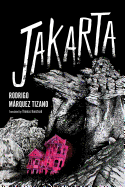
"A labyrinth, he concluded, is nothing but a way of seeing," Mexico City-born editor and journalist Rodrigo Márquez Tizano writes near the end of Jakarta, the dense yet slender lulu of a first novel translated from the Spanish by Thomas Bunstead.
Outraged and outrageous, disgusted and disgusting, every bit a miniature labyrinth in itself, Jakarta offers a way of seeing, over its 160 pages. Tizano summons the past, present and future of Atlantika, an invented Latin American city continually beset with plagues, as understood by an exterminator who beholds visions of his own and his country's history through a glowing stone in a small apartment as life rots away outside.
With the splattery verve of a horror writer, Tizano guides readers through his narrator's experience gathering diseased corpses and slaughtering rats--underground their "thousands" of eyes glow like "multicolored sequins." But Jakarta is horror-touched rather than horror itself, with beguiling short chapters--running from a few lines to a couple of pages, without paragraph breaks--and a mad variety of interests. One burst of prose might consider the history of infections over centuries, quoting fictitious journals from original European invaders, who let disease implement the hard work of conquest. The next might hilariously survey the fervor for a made-up team sport in Atlantika in the days before the final outbreak, or recall the nun whose geography lessons years ago inspired the narrator to fantasize about unknowable Jakarta. To show it all at once, Tizano dares readers to get a little lost. --Alan Scherstuhl, freelance writer and editor

